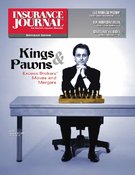Providing rewards programs that attract, motivate and help retain employees has been ranked among the top five priorities for employers in 2005, according to a new survey conducted by Deloitte Consulting LLP’s Human Capital practice and the International Society of Certified Employee Benefit Specialists.
More than half of nearly 350 employee benefit specialists in the United States said that consideration of how employee rewards programs help attract, retain, and motivate workforce talent is a priority next year–the first time attraction and retention considerations have been rated this high in the 11-year history of the Top Five Total Rewards Priorities Survey.
Controlling health care benefit costs has again been ranked as the No. 1 overall employee benefit priority, the sixth consecutive year in the top spot, with more than 90 percent calling it their top issue. Talent management was the second highest ranked priority at 56 percent.
“Employers are concerned about not only the cost and management of benefit plans for their employees, but also how those plans will actually shape who makes up their workforce,” said Tim Phoenix, principal and national leader of Deloitte Consulting’s Total Rewards service area.
“As baby boomers approach retirement and the talent race grows more competitive, cost-effective and consumer-friendly benefit packages will become increasingly important to employers wanting to succeed in talent management,” he added.
The survey of ISCEBS-member employee benefit specialists was conducted electronically earlier this fall to identify priorities for 2005. Respondents were asked to consider all total rewards programs including all compensation, benefits, perquisites and any other direct or indirect payments made to their employees.
Employers rated increasing employee responsibility as their third priority. Reducing costs in the benefits arena in two ways: cost-sharing (52 percent) and employee management of how they spend their benefit dollars (42 percent) ranked as the fourth priority. Managing retirement benefit costs rounded out the top five priorities at 41 percent.
The survey also asked participants to identify actions they have undertaken relative to their organization’s total rewards programs within the past 12 months, or expect to take during the next 12 months, checking all that apply.
Approximately 83 percent of employers have either increased employee cost-sharing in health and welfare programs in the last 12 months or plan to do so in the next 12 months. Almost three-quarters (72 percent) of employers are placing increased emphasis on consumerism for employee health and welfare programs. In terms of post-retirement plans, 23 percent of employers surveyed plan to increase consumerism and 33 percent plan to increase cost-sharing.
Eighty-five percent of respondents have focused, or will focus, on increasing employee communication and education efforts related to their reward programs. Approximately 68 percent of employers have increased, or will increase, the use of employee self-service technology, and 65 percent have recently provided, or will soon provide, employees with better tools to plan for their retirement needs.
More than two-thirds of employers have redesigned, or will redesign, some of their rewards programs to better align the interests of the employees and company. Approx-imately 44 percent surveyed have already improved their ability to measure return on investment of rewards programs, or will within the next 12 months.
Additional results of interest include:
Approximately 40 percent of employers surveyed have shifted to lower-cost providers in the past 12 months or will in the next 12 months.
Furthermore, 44 percent of employers have increased, or will increase, the use of outsourced administration providers, and 22 percent have made, or will make, the change to consolidate the number of outsourced administration providers currently used by their organization. Due to the focus on cost control, it is no surprise that some employers are looking to reduce total rewards packages and benefit levels for their employees. Approximately 29 percent of employers have already reduced the number of plans options available to active employees or will in the next 12 months.
Regarding retirement plans, only 16 percent of employers surveyed have eliminated or frozen participation on post-retirement plans or will in the next 12 months. The same number of employers (16 percent) has already reduced benefit levels for retirees or will in the coming year.
Was this article valuable?
Here are more articles you may enjoy.


 Alliant Latest to Sue Howden US Over Alleged ‘Smash-and-Grab’ Poaching
Alliant Latest to Sue Howden US Over Alleged ‘Smash-and-Grab’ Poaching  Expense Ratio Analysis: AI, Remote Work Drive Better P/C Insurer Results
Expense Ratio Analysis: AI, Remote Work Drive Better P/C Insurer Results  New York State Police Report 37-Vehicle Pileup on I-81 Near Syracuse
New York State Police Report 37-Vehicle Pileup on I-81 Near Syracuse  Grandson Not Covered Under Grandma’s Home Insurance
Grandson Not Covered Under Grandma’s Home Insurance 


